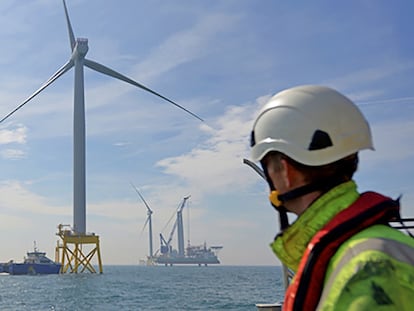Fed’s rate hike is the most aggressive since the 1980s
After bumping up interest rates by 0.75 points, the US central bank is now preparing for two new rises in the price of money in November and December


As expected, the Federal Reserve is accelerating its interest rate hikes to slow down the economy (and thus inflation). The US central bank on Wednesday raised the short-term federal funds rate by 0.75 percentage points to 3.25%, representing three consecutive rises of 0.75 points in the official price of money. That is already the sharpest tightening of monetary policy since the early 1980s, when Paul Volcker headed the Fed. The title of Volcker’s autobiography, Keeping At It, has become a personal motto for current Fed chief Jerome H. Powell.
He pronounced the phrase in August at a leading economic gathering in Jackson Hole (Wyoming) and on Wednesday he repeated it a few times: “The FOMC [Federal Open Market Committee] is strongly resolved to bring inflation down to 2%, and we will keep at it until the job is done.” What does this imply? According to the forecasts by the majority of the members of the committee, it means raising rates to around 4.38% by the end of the year, up from the current 3%-3.25%.
A majority of committee members foresees an additional tightening of 125 basis points (1.25 percentage points), although there are almost as many who feel the hike will be 100 basis points. The decisions will be made at two monetary policy meetings scheduled for what’s left of the year, one on November 1-2 and another on December 14-15. Until then, it seems clear is that there will be two more sharp rate hikes on those dates, most likely 75+50 basis points or else 50+50.
Powell has altogether stopped talking about the neutral interest rate, the one that neither slows down nor stimulates the economy. Initially, his purpose was to get there and then reevaluate the situation. Now he is speaking openly of a restrictive monetary policy and his view is that after this week’s rise, there is still “a way to go.”
The tone of his entire news conference was markedly hawkish: “No one knows whether this process will lead to a recession or if so how significant that recession would be.”
Tu suscripción se está usando en otro dispositivo
¿Quieres añadir otro usuario a tu suscripción?
Si continúas leyendo en este dispositivo, no se podrá leer en el otro.
FlechaTu suscripción se está usando en otro dispositivo y solo puedes acceder a EL PAÍS desde un dispositivo a la vez.
Si quieres compartir tu cuenta, cambia tu suscripción a la modalidad Premium, así podrás añadir otro usuario. Cada uno accederá con su propia cuenta de email, lo que os permitirá personalizar vuestra experiencia en EL PAÍS.
¿Tienes una suscripción de empresa? Accede aquí para contratar más cuentas.
En el caso de no saber quién está usando tu cuenta, te recomendamos cambiar tu contraseña aquí.
Si decides continuar compartiendo tu cuenta, este mensaje se mostrará en tu dispositivo y en el de la otra persona que está usando tu cuenta de forma indefinida, afectando a tu experiencia de lectura. Puedes consultar aquí los términos y condiciones de la suscripción digital.
More information
Últimas noticias
Most viewed
- David King, chemist: ‘There are scientists studying how to cool the planet; nobody should stop these experiments from happening’
- Reinhard Genzel, Nobel laureate in physics: ‘One-minute videos will never give you the truth’
- Mexico completes its trade shift with the entry into force of tariffs on China and countries without trade agreements
- Oona Chaplin: ‘I told James Cameron that I was living in a treehouse and starting a permaculture project with a friend’
- Sinaloa Cartel war is taking its toll on Los Chapitos










































